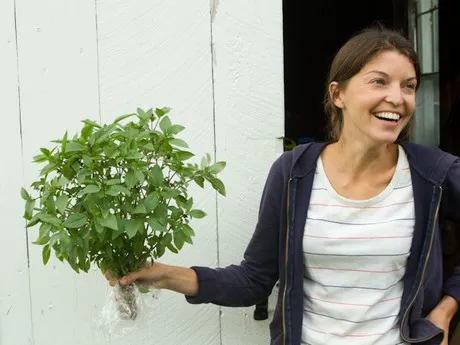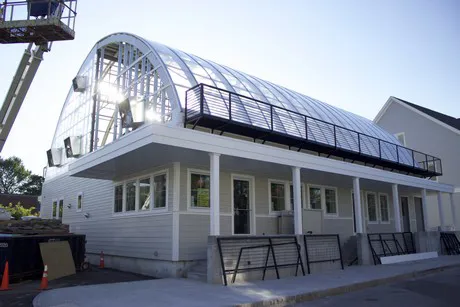Consumers, supermarkets and restaurants are increasingly going for local produce. They do this by going to the farmers' market, sourcing fruit and vegetables from small-scale growers in the area, or growing produce right next to the restaurant table. Asian-fusion restaurant Tao Yuan in Maine is taking this hyperlocal trend to the next level, by building an aquaponics greenhouse on the roof next door.
Since they started, the owners had the idea for a greenhouse next door to the restaurant, according to Kate Holcomb, founder/director of Canopy Farms, the company behind the greenhouse. "The idea of growing hyperlocal, super fresh, specialty produce appealed; additionally, we saw the potential in Maine for year-round, more energy-efficient growing to really take off. We're part of a sustainable year-round agriculture cluster -- a network of folks (including producers like us) who are working to demonstrate some of the new technologies and production methods for year-round growing, engage in educational and workforce development in these areas, and showcase all of this to the public to get the word out."

Kate continues: "We saw the opportunity to do something that not only could add value to our business (great ingredients, more consistent and varied work for our employees), but also allowed our restaurant to be a part of the community in a different and really meaningful way. So Canopy Farms L3C is its own entity, and Tao Yuan restaurant is a partner and collaborator, but the farm operates as a mission-driven enterprise."
Greenhouse/restaurant integration
Construction for this project is complicated, Kate tells us. "It's been years since we started the process of designing the building, getting town approval, and hiring the right people to make it happen -- but the building exterior is nearing completion! We're just beginning to construct the production system itself."
The unique thing about this project, which also brings additional challenges, is that it integrates the greenhouse into the construction of the restaurant. "One challenge has been trying to do so much -- there are a lot of moving parts, and it can be difficult to balance the needs of all the factors involved... It could be balancing physical needs (ideal pH for fish vs. plants), things that need attention (running a restaurant demands a lot of time and effort, so taking on such a big project at the same time is a lot!) or financial needs (which technologies can we afford to invest in, at the expense of which others?). Plus, aquaponics of this kind is still very much a developing field, so there are a lot of unknowns."
Also, since the restaurant greenhouse (or greenhouse restaurant) is intended to be a showcase, they need to be sure that the system functions well, but also looks nice and can be a bit more accessible (for research projects, school visits, etc.). "We'll benefit from being right next door, and able to harvest immediately", Kate says, "but that does mean that we need to have a consistent small amount of many different products. So in our relatively small space, we'll have to have a lot of variety -- and we'll need to be able to make a wide range of plants happy."
Rainbow trout... and wasabi?
Kate tells us that for the fish part of the aquaponics operation, they decided to go with rainbow trout, "because they are a delicious fish that's available in the area. For crops, we want to begin with some things that we know grow well in aquaponics, and that we know we can use (leafy greens, herbs), and as we grow, move on to some specialty crops -- maybe lotus root, wasabi -- that are difficult to get fresh here and are really wonderful ingredients for our cuisine."
Kickstarter
The response to the project so far has been really good: "Many people know we've been working on this for years, and they've been excited to see it happen. A lot of our regular customers value local, healthy, responsibly-grown food; they're glad that we'll be serving our own crops in the restaurant for them to enjoy, and also that we're a part of trying to grow year-round sustainable ag in Maine."
Right now, they're running a
Kickstarter campaign (which ends August 28) to raise funds to support some of the more community-focused aspects of what they're doing (support for interns, data sharing, etc.), and as a result they've been trying to get the word out more. "Most people who hear about our project are really intrigued, whether it's from a food, energy, or workforce development perspective."
Local future
So is this type of hyperlocal production the future of the restaurant business? Kate sees new ways of doing local being very important in food production overall. "Figuring out how to grow food sustainably in our own communities (rural and urban, tropical and temperate) will give us better, fresher food, cut down on transportation, and creates beautiful spaces for the community. So I think it's the future of the restaurant business and beyond!"
For more information:
 Canopy Farms
Canopy Farms

 Canopy Farms
Canopy Farms


 Canopy Farms
Canopy Farms